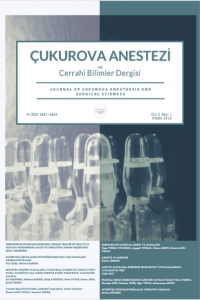Öz
Uyanık kraniyotomi tekniği ilk olarak epilepsinin cerrahi tedavisinde kullanılmış ve daha sonra kritik beyin bölgelerine yakın, supratentoriyal tümörlerin cerrahi tedavisinde veya arteriyovenöz malformasyon gibi lezyonların tedavisinde kullanılmıştır. Bu cerrahi yaklaşım; motor, somatosensör ve dil alanları gibi beynin önemli alanlarını korurken, lezyon rezeksiyonunu maksimum düzeyde gerçekleştirmeyi amaçlar. Bu cerrahi teknik sırasında, hastanın cerrahiye aktif katılımı, kortikal haritalamayı kolaylaştırmak için gereklidir. Bu tip bir prosedürde, anestezistin amacı, operasyonu güvenli ve etkili kılmak; ayrıca hastanın psikofiziksel rahatsızlığını azaltmaktır. Literatürde uyanık kraniyotomi için pek çok anestezi protokolü tanımlanmakla birlikte, en iyi anestezi tekniğine dair ortak bir fikir birliğine henüz ulaşılamamıştır. Biz de bu yazıda; frontal bölgede Broka alanına yakın tümörü olan bir hastadaki anestezik yaklaşımımızı sunmayı amaçladık.
Anahtar Kelimeler
Kaynakça
- 1. July J, Manninen P, Lai J, et al. The history of awake craniotomy for brain tumor and its spread into Asia. Surg Neurol. 2009; 71:621-45.
- 2. Burchiel KJ, Clarke H, Ojemann GA, et al. Use of stimulation mapping and corticography in the excision of arteriovenous malformations in sensorimotor and language-related neocortex. Neurosurg. 1989;24:322-7.
- 3. Duffau H, Capelle L, Sichez JP, et al. Intra-operative direct stimulations of the central nervous system: the Salptrière experience with 60 patients. Acta Neurochir (Wien). 1999; 141:1157-67.
- 4. Lüders JC, Steinmetz MP, Mayberg MR. Awake craniotomy for microsurgical obliteration of mycotic aneurysms: technical report of three cases. Neurosurg. 2005; 56:ONS-E201.
- 5. Brown T, Shah AH, Bregy A, et al. Awake craniotomy for brain tumor resection: the rule rather than the exception? J Neurosurg Anesthesiol. 2013; 25:240–7.
- 6. Bilotta F, Rosa G. 'Anesthesia' for awake neurosurgery. Curr Opin Anaesthesiol. 2009; 22:560–5.
- 7. Huncke K, Van De Wiele B, Fried I, et al. The asleep-awake-asleep anesthetic technique for intraoperative language mapping. Neurosurgery. 1998; 42:1312-7.
- 8. Ghisi D, Fanelli A, Tosi M, et al. Monitored anesthesia care. Minerva Anestesiol. 2005; 71: 533–8.
- 9. Olsen KS. The asleep-awake technique using propofol-remifentanil anaesthesia for awake craniotomy for cerebral tumours. Eur J Anaesthesiol. 2008; 25:662-9.
- 10. Hansen E, Seemann M, Zech N, et al. Awake craniotomies without any sedation: the awake-awake-awake technique. Acta Neurochir (Wien). 2013; 155:1417–24.
- 11. Wolfson R, Soni N, Shah AH, et al. The role of awake craniotomy in reducing intraoperative visual field deficits during tumor surgery. Asian J Neurosurg. 2015; 10:139-44.
- 12. Chakrabarti R, Tewari A, Sinha A, et al. Awake craniotomy: A qualitative review and future challenges. Saudi J Anaesth. 2014; 8:529-39.
- 13. Hans P, Bonhomme V. Why we still use intravenous drugs as the basic regimen for neurosurgical anaesthesia. Curr Opin Anaesthesiol. 2006; 19:498-503.
- 14. Herrick IA, Craen RA, Gelb AW, et al. Propofol sedation during awake craniotomy for seizures: electrocorticographic and epileptogenic effects. Anesth Analg. 1997; 84:1280-4.
- 15. Piccioni F, Fanzio M. Management of anesthesia in awake craniotomy. Minerva Anestesiol. 2008; 74:393-408.
- 16. Gignac E, Manninen PH, Gelb AW. Comparison of fentanyl, sufentanil and alfentanil during awake craniotomy for epilepsy. Can J Anaesth. 1993; 40:421-4.
- 17. Manninen PH, Balki M, Lukitto K, et al. Patient satisfaction with awake craniotomy for tumor surgery: A comparison of remifentanil and fentanyl in conjunction with propofol. Anesth Analg. 2006; 102:237-42.
- 18. Bekker AY, Kaufman B, Samir H, et al. The use of dexmedetomidine infusion for awake craniotomy. Anesth Analg. 2001; 92:1251–3.
- 19. Shen S-L, Zheng J-Y, Zhang J, et al. Comparison of dexmedetomidine and propofol for conscious sedation in awake craniotomy: a prospective, double-blind, randomized, and controlled clinical trial. Ann Pharmacother. 2013; 47:1391–9.
- 20. Peruzzi P, Bergese SD, Viloria A, et al. A retrospective cohort-matched comparison of conscious sedation versus general anesthesia for supratentorial glioma resection. Clinical article. J Neurosurg. 2011; 114: 633–9.
- 21. Souter MJ, Rozet I, Ojemann JG, et al. Dexmedetomidine sedation during awake craniotomy for seizure resection: effects on electrocorticography. J Neurosurg Anesthesiol. 2007; 19:38–44.
- 22. Sokhal N, Rath GP, Chaturvedi A, et al. Anaesthesia for awake craniotomy: A retrospective study of 54 cases. Indian J Anaesth. 2015; 59:300–5.
- 23. Lobo F, Beiras A. Propofol and remifentanil effect-site concentrations estimated by pharmacokinetic simulation and bispectral index monitoring during craniotomy with intraoperative awakening for brain tumor resection. J Neurosurg Anesthesiol. 2007; 19:183-9.
- 24. Balki M, Manninen PH, McGuire GP, et al. Venous air embolism during awake craniotomy in a supine patient. Can J Anaesth. 2003; 50:835-8.
Ayrıntılar
| Birincil Dil | Türkçe |
|---|---|
| Konular | Anesteziyoloji |
| Bölüm | Olgu Sunumları |
| Yazarlar | |
| Yayımlanma Tarihi | 30 Nisan 2019 |
| Kabul Tarihi | 23 Nisan 2019 |
| Yayımlandığı Sayı | Yıl 2019 Cilt: 2 Sayı: 1 |

